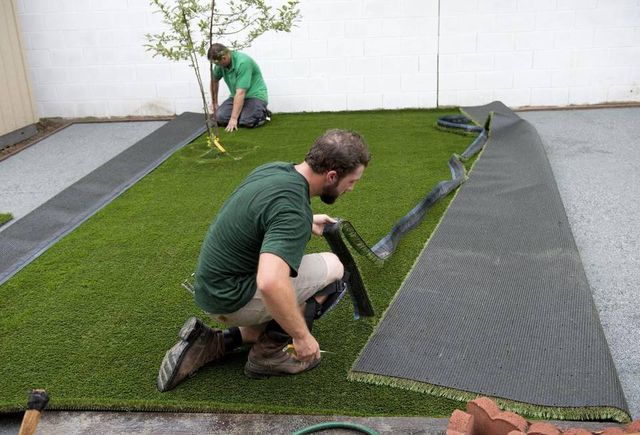Artificial grass is a fantastic way to achieve a lush, green lawn without the hassle of mowing, watering, or fertilising. It’s durable, looks beautiful year-round, and requires far less upkeep than natural grass. However, like any outdoor feature, artificial grass installation Durham still needs some maintenance to keep it looking its best and to ensure it remains in top condition for many years.
In this article, we’ll break down the key maintenance tasks that should be carried out after installing artificial grass, so you can enjoy a pristine lawn with minimal effort.
1. Regular Brushing
One of the simplest maintenance tasks you can do for your artificial grass is regular brushing. Over time, the grass blades can become flattened due to foot traffic, pets, or weather conditions. Brushing the grass with a stiff broom or a specialised turf brush helps to lift the blades back to their natural upright position, maintaining the appearance of a lush, realistic lawn.
Brushing also helps to remove debris, such as leaves or dirt, that may accumulate on the surface. Ideally, you should brush your artificial grass once every two weeks, or more often if the area experiences high foot traffic or heavy rainfall.
2. Cleaning Up Debris
Although artificial grass is designed to be low-maintenance, it can still collect leaves, twigs, and other debris. Regular cleaning is essential to prevent organic material from breaking down and potentially causing odours or affecting drainage.
For most small debris, simply using a leaf blower or a rake will do the trick. For stubborn dirt or pet waste, you can use a hose to wash the surface. Just make sure you rinse thoroughly to ensure nothing gets stuck in the grass fibres. If you have an area with heavy debris, consider using a vacuum designed for artificial grass to make the task easier.
3. Washing Your Artificial Grass
While artificial grass doesn’t require watering like natural grass, it still benefits from an occasional rinse to keep it clean. Washing your artificial lawn helps to remove dust, grime, and any pet waste, and also keeps the grass fresh and odour-free.
A light rinse with a hose is typically sufficient for regular cleaning. However, if your artificial grass is located in a particularly dusty or dirty environment, or if you have pets, you may want to wash it more frequently. Using a mild soap or turf cleaner can help maintain the cleanliness of your lawn without damaging the fibres.
4. Dealing with Stains and Spills
One of the advantages of artificial grass is its resistance to stains. However, spills from food, drink, or other substances can occasionally occur, especially in areas with high foot traffic or entertainment spaces. Fortunately, cleaning up spills is relatively straightforward.
For liquid spills, simply blot the area with a clean cloth or sponge. For solid spills, scrape off the debris with a plastic spatula or similar tool. For more stubborn stains, you can use a gentle detergent mixed with water to scrub the affected area. Always make sure to rinse thoroughly after cleaning to avoid any residue buildup.
5. Addressing Pet Waste
If you have pets, artificial grass can be a great option, but it does require a little extra care when it comes to cleaning. Pet waste, including urine and faeces, should be removed promptly to avoid odour buildup.
For pet urine, rinse the area with water to dilute and flush away the liquid. If your pet regularly uses the lawn, you may want to install a drainage system to help with this process. For solid waste, simply remove it in the same way you would from a natural lawn. You can use a dog waste bag, scoop, or similar tool to dispose of it.
In some cases, you might want to use a pet-safe disinfectant or deodorizer to ensure your artificial grass stays fresh and hygienic.
6. Weeding (Occasionally)
Artificial grass is designed to prevent weed growth by creating a dense, impermeable layer that stops seeds from taking root. However, in some rare cases, weeds may still grow around the edges or through seams if there are gaps in the base layer or poor installation.
To prevent this, make sure the base is properly prepared during the installation process. If weeds do appear, use a weed killer designed for artificial grass, or carefully pull them out by hand. It’s important to avoid using harsh chemicals that could damage the turf.
7. Maintaining Proper Drainage
Good drainage is one of the key features of artificial grass. To maintain it, ensure that water flows freely through the turf and doesn’t pool on the surface. If you notice any areas where water accumulates, it may be a sign that the ground beneath the grass has become uneven, or that the drainage system is clogged.
You can address minor drainage issues by brushing the area to help redistribute the surface materials and encourage proper flow. In more serious cases, you may need to consult with a professional installer, like Landscapers Durham, to evaluate and resolve the problem.
8. Repairing Minor Damage
While artificial grass is highly durable, it can still sustain minor damage over time, particularly in areas with heavy use. If you notice any areas where the grass has become torn, flattened, or damaged, it’s best to address the issue promptly.
Small repairs can usually be carried out by cutting out the damaged section and replacing it with a fresh piece of turf. For more extensive damage, professional repair services can ensure the grass is restored to its original condition.
9. Replenishing the Infill
Infill is the material that’s spread between the grass fibres to help them stay upright, provide cushioning, and assist with drainage. Over time, infill may settle or wash away due to foot traffic, weather, and cleaning. When this happens, it’s important to replenish the infill to maintain the look and functionality of your artificial grass.
A professional installer can help with this process, but for minor replenishment, you can buy infill material and distribute it across the turf with a rake. The type of infill you use will depend on your specific needs, such as sand, rubber crumb, or organic infill.
Conclusion
While artificial grass is a low-maintenance option compared to natural lawns, it’s important to give it some care to keep it looking its best. Regular brushing, cleaning, and upkeep will help ensure your artificial grass remains in top condition for years to come. Whether it’s keeping your grass debris-free, addressing pet waste, or making sure the drainage is working correctly, these simple tasks will keep your lawn looking lush and beautiful.
If you ever need assistance with the upkeep or repair of your artificial grass, don’t hesitate to get in touch with Landscapers Durham. Our team of experts is always here to help keep your outdoor space looking fantastic year-round!



